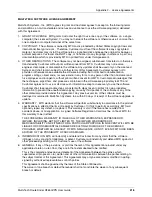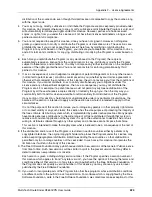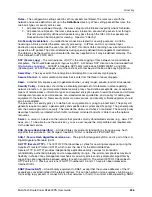
Glossary
Multi-Tech RouteFinder RF650VPN User Guide
231
Host
– In client-server architectures, the computer on which the server software is running is called the
host. It is possible for several servers to be running on one host, e.g. one FTP server and one e-mail
server. Hosts can be accessed with the help of clients, e.g. with a browser or an e-mail program. As the
expression server is used for the program (i.e. the software) as well as for the computer on which the
program is running (i.e. the hardware), server and host are not clearly separated in practice. In data
telecommunication the computer from which information (such as FTP flies, news, www pages) is
fetched, is called the host. A host is also called a node in the Internet. Using an Internet host (as opposed
to a local host), it is possible to work from a distance (remote access).
Host
– A computer that allows users to communicate with other host computers on a network. Individual
users communicate by using application programs, such as electronic mail, Telnet and FTP.
HTTPS (aka, S-HTTP)
– Secure HyperText Transfer Protocol, a secure way of transferring information
over the World Wide Web. HTTPS refers to the entry (e.g.,
https://192.168.2.100
) used for an S-HTTPS
connection. S-HTTPS is the IETF RFC that describes a syntax for securing messages sent using the
Hypertext Transfer Protocol (HTTP), which forms the basis for the World Wide Web. S-HTTP provides
independently applicable security services for transaction confidentiality, authenticity/integrity and non-
repudiability of origin.
S-HTTP emphasizes maximum flexibility in choice of key management mechanisms, security policies and
cryptographic algorithms by supporting option negotiation between parties for each transaction.
ICMP
– The Internet Control Message Protocol notifies the sender of IP datagrams about abnormal
events. ICMP might indicate, for example, that an IP datagram cannot reach an intended destination,
cannot connect to the requested service, or that the network has dropped a datagram due to old age.
ICMP also provides information back to the transmitter, such as end-to-end delay for datagram
transmission.
IETF (Internet Engineering Task Force)
– The international standards body that has standardized the IP
protocol and most of the other successful protocols used on the Internet. The IETF web page is at
http://www.ietf.org/
.
IKE (Internet Key Exchange)
– A hybrid Internet protocol used to establish a shared security policy and
authenticated “keys” for services, such as IPSec, that require keys.
IP
– The Internet Protocol (IP) is the basic protocol for the transmission of information in the Internet,
that has been in use virtually unchanged since 1974. It establishes and ends connections, as well as
recognising errors. By using NAT and Masquerading, private networks can be mapped onto official IP
addresses. This way, the Ipv4 address space will still last a long time. Standard Internet open protocols
include:
Protocol
Function
TCP/IP
basic network communication
HTTP
browsing
NFS File
Service
IMAP4/SMTP Mail
Service
DNS
Naming Service
DNS/LDAP
Directory Services
Bootp/DHCP Booting
Services
SNMP Network
Administration
IP Address
– A 32-bit number that identifies the devices using the IP protocol. An IP address can be
unicast, broadcast, or multicast. See RFC 791 for more information. Every host has a clear IP address,
comparable with a telephone number. An IP address consists of four decimal numbers between 1 and
254, divided by dots (e.g., a possible IP address is 212.6.145.0. At least one name of the form xxx
belongs to every IP address (e.g. xxx). This defines a computer with the name ox that is in the sub
domain xxx of the sub domain xxx of the domain xxx. Like with IP addresses, the individual name parts
are divided by dots. However, as opposed to IP addresses, IP names are not limited to four parts. Also,
several IP names can be assigned to one IP address; these are referred to as aliases.






























